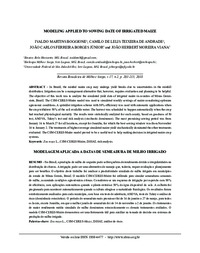Modeling applied to sowing date of irrigated maize.
Modeling applied to sowing date of irrigated maize.
Author(s): BOGGIONE, I. M.; ANDRADE, C. de L. T. de; BORGES JÚNIOR, J. C. F.; VIANA, J. H. M.
Summary: In Brazil, the rainfed maize crop may undergo yield breaks due to uncertainties in the rainfall distribution. Irrigation can be a management alternative that, however, requires evaluation and planning to be helpful. The objective of this work was to analyze the simulated yield data of irrigated maize in counties of Minas Gerais state, Brazil. The CSM-CERES-Maize model was used to simulated weekly sowings of maize considering optimum agronomic conditions. A sprinkler irrigation scheme with 80% efficiency was used with automatic applications when the crop withdrew 50% of the soil available water. The harvest was scheduled to happen automatically when the crop had reached physiological maturity. The results were statistically analyzed for each county, based on goodness of fit test, ANOVA, Tukey?s test and risk analysis (stochastic dominance). The most promising sowing period was from January 16 to March 27 for all locations, except for Janaúba, for which the best sowing window was from November 14 to January 2. The treatments of highest average simulated maize yield stochastically dominated the other treatments evaluated. The CSM-CERES-Maize model proved to be a useful tool to help making decision in irrigated maize crop systems.
Publication year: 2018
Types of publication: Journal article
Unit: Embrapa Maize & Sorghum
Keywords: Análise de Risco, CSM-CERES-Maize, DSSAT, Irrigação, Modelagem, Modelo de Simulação
Observation
Some of Embrapa's publications are published as ePub files. To read them, use or download one of the following free software options to your computer or mobile device. Android: Google Play Books; IOS: iBooks; Windows and Linux: Calibre.
Access other publications
Access the Agricultural Research Database (BDPA) to consult Embrapa's full library collection and records.
Visit Embrapa Bookstore to purchase books and other publications sold by Embrapa.

